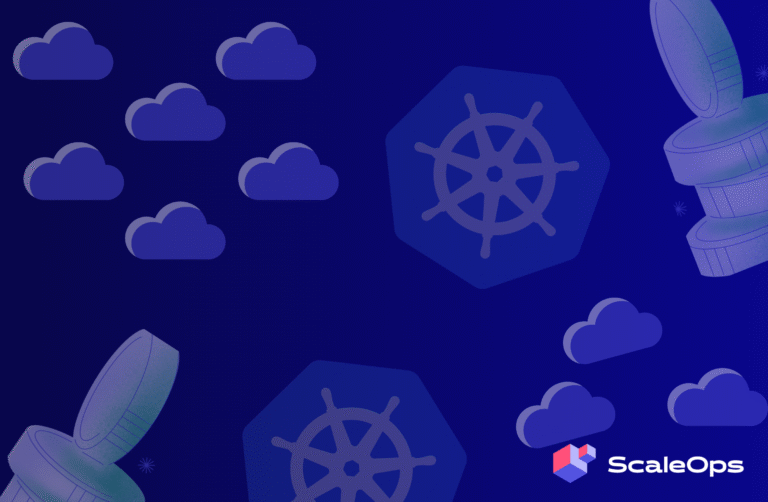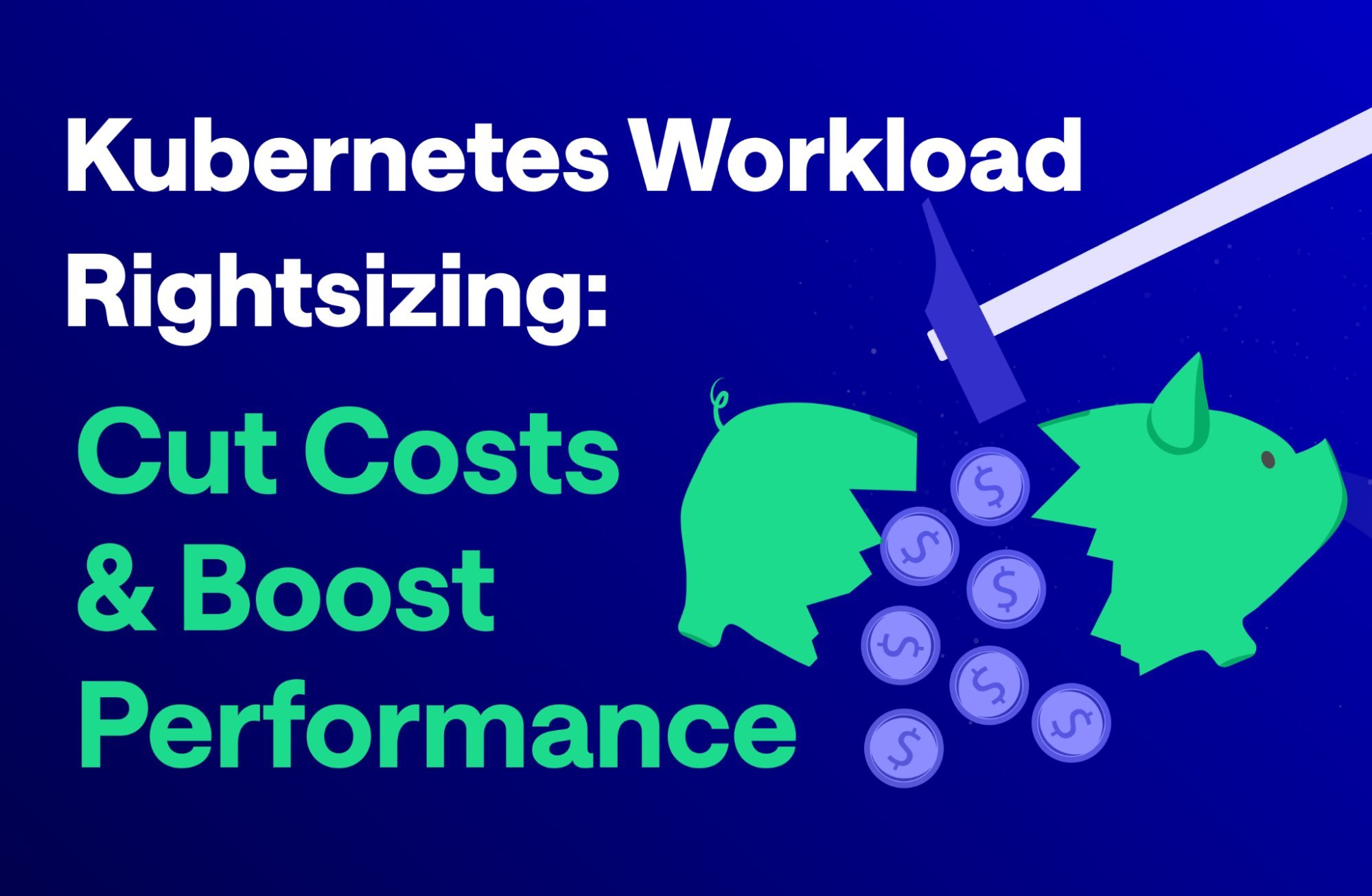In the rapidly changing digital environment, Kubernetes has become the go-to platform for managing and scaling applications. However, achieving the ideal balance between performance and cost efficiency remains a challenge. Misconfigured workloads, whether over or under-provisioned, can result in wasted resources, inflated costs, or compromised application performance. Rightsizing Kubernetes workloads is critical to ensuring optimal resource utilization while maintaining seamless application functionality. This guide will cover the core concepts, effective strategies, and essential tools to help you fine-tune your Kubernetes clusters for peak efficiency.
What is Kubernetes Workload Rightsizing?
Kubernetes workload rightsizing is the process of allocating the optimal amount of CPU, memory, and other resources to applications running in a Kubernetes cluster. The goal is to ensure that workloads have enough resources to operate efficiently without over-provisioning or impacting workload performance. Rightsizing is an essential strategy for sustaining cost-effectiveness and performance in Kubernetes environments. It minimizes resource waste and ensures applications remain responsive, even as workloads fluctuate.
Why is Rightsizing Important?
Kubernetes rightsizing is crucial for increasing resource utilization and minimizing costs. Accurately allocating resources to pods prevents over-provisioning, leading to reduced infrastructure expenses and improved resource efficiency.
| Scenario | Consequences | Mitigation |
|---|---|---|
| Over-Provisioning | Increased costs, inefficient resource utilization, inaccurate scaling | Monitor resource usage, reduce resource requests |
| Under-Provisioning | Reduced performance, application failures, poor user experience, increased operational difficulties, potential downtime | Monitor workload performance (peak and regular) and increase resource requests |
How to Rightsize Kubernetes Workloads
To ensure workloads are accurately analyzed and optimized, follow these actionable steps to achieve peak performance and cost efficiency:
Analyze Resource Usage
Understanding how workloads use resources is the first step in rightsizing. Tools such as kubectl top and Kubernetes dashboards offer fundamental insights into resource usage for both pods and nodes. For a more in-depth analysis, monitoring solutions like Prometheus and Grafana can help visualize trends in resource consumption over time.
Practical Example: Fetch Resource Usage for Pods in a Namespace
kubectl top pods --namespace=your-namespaceThe above command will give the namespace-specific pods’ CPU and memory usage details. This way, users will understand which workload is taking more resources than needed or has less allocation.
Set Resource Requests and Limits
Resource requests and limits are essential settings in Kubernetes. Requests indicate the minimum resources that a container is guaranteed, whereas limits set the maximum resources it can use. Correctly configuring these parameters ensures that workloads receive the necessary resources without interfering with other operations in the cluster.
Example: YAML Configuration
apiVersion: v1
kind: Pod
metadata:
name: example-pod
spec:
containers:
- name: example-container
image: nginx
resources:
requests:
memory: "256Mi"
cpu: "500m"
limits:
memory: "512Mi"
cpu: "1
In this example, the container will have 256Mi of memory and 500m (0.5 CPU), but it cannot go beyond 512Mi of memory and 1 CPU. These configurations should align with historical data from resource monitoring tools.
Use a Tool Like Vertical Pod Autoscaler (VPA)
Vertical Pod Autoscaler (VPA) automates the adjustment of resource requests and limits for containers, minimizing the manual effort required for monitoring and configuring resources. Platforms such as ScaleOps replace VPA as a robust resource management platform that performs (among many other things) vertical scaling of pods.
To use VPA:
1. Install the VPA components (recommender, updater, and admission controller) in your cluster.
2. Enable recommendations for workloads.
kubectl describe vpa [vpa-name]3. Integrate ScaleOps for advanced automation and insights.
VPA Installation Example
kubectl apply -f https://github.com/kubernetes/autoscaler/blob/master/vertical-pod-autoscaler/deploy/recommender.yaml
The above command makes sure the VPA is active in the cluster and will do resource adjustments.
Use Autoscaling
The Horizontal Pod Autoscaler (HPA) adjusts the number of pod replicas according to resource usage metrics. When used alongside the Vertical Pod Autoscaler (VPA), it helps maintain both scalability and resource efficiency for workloads. For instance, HPA can increase the number of replicas during periods of high traffic, while VPA fine-tunes the resource settings for each pod. However, when using HPA with utilization metrics alongside VPA, be cautious, as it can lead to instability in scaling behavior.
HPA Example
apiVersion: autoscaling/v2
kind: HorizontalPodAutoscaler
metadata:
name: example-hpa
spec:
scaleTargetRef:
apiVersion: apps/v1
kind: Deployment
name: example-deployment
minReplicas: 2
maxReplicas: 10
metrics:
- type: Resource
resource:
name: cpu
target:
type: Utilization
averageUtilization: 70
This configuration maintains CPU utilization around 70% by scaling the number of replicas between 2 and 10 as needed.
4 Steps to Rightsize Kubernetes Workloads
Below are some practical steps to achieve optimal resource allocation in your Kubernetes environment by rightsizing the workloads:
Step 1: Monitor Resource Usage
Start by collecting detailed resource usage data for all workloads. Use tools like ScaleOps to track usage patterns comprehensively. Ensure your data captures various scenarios, including peak and off-peak periods, to better understand real-world resource demands. Monitoring tools can provide valuable insights by visualizing trends in key metrics like CPU, memory, and disk I/O, helping you assess workload performance under diverse conditions.
Step 2: Identify Underutilized and Overutilized Resources
Analyze the collected data to identify workloads that are consuming excessive resources or struggling with insufficient allocations. For underutilized resources, adjust requests and limits to reduce unnecessary costs. Conversely, workloads nearing their resource limits, such as a pod using 90% of its CPU limit, require scaling to prevent performance throttling during peak usage.
Step 3: Deploy Appropriate Resource Requests and Limits
Using the information that you have gathered, update the resource configurations of workloads to make them more appropriate. Ensure that requests match the average usage expectations while limits account for the occasional spikes. The appropriate rightsizing involves balancing resource efficiency and workload reliability. You will need to regularly review historical usage data and engage application owners for decision-making.
Step 4: Test and Tune Workloads
Before deploying changes to production, test them in a staging environment by simulating both normal and high-traffic scenarios. Observe workload performance and stability, making necessary adjustments to fine-tune the configurations. This iterative process ensures that the settings are robust and effective, minimizing the risk of disruptions when changes are promoted to production.
Benefits of Kubernetes Workload Rightsizing
Rightsizing Kubernetes workloads offers several benefits, including cost savings, reduced workload for operations teams, and improved application performance. Let’s explore them in more detail:
- Cost Optimization: Rightsizing eliminates unnecessary resource allocations, resulting in significant Kubernetes cost optimization. By aligning resource requests with actual needs, organizations can optimize cloud spending and allocate budgets more effectively.
- Improved Application Performance: Rightsizing ensures workloads have sufficient resources for optimal performance. This leads to faster response times, reduced latency, and improved user experience, enabling applications to consistently meet service-level objectives.
- Enhanced Resource Utilization: Efficient resource allocation maximizes cluster utilization, minimizes wastage, and reduces bottlenecks. Rightsizing allows organizations to support more applications on the same hardware while maintaining optimal performance.
- Preventing Operational Challenges: Rightsizing reduces the risk of resource bottlenecks, node pressure, and unexpected scaling failures, ensuring stable cluster operations. It also streamlines team operations by minimizing the need for reactive firefighting, reducing manual interventions, and allowing DevOps teams to focus on strategic improvements rather than constant troubleshooting.
Key Challenges in Kubernetes Workload Rightsizing
Rightsizing Kubernetes workload is not a simple job. It comes with many complex challenges and trade-offs of important design aspects.
| Challenges | Description |
|---|---|
| Lack of Accurate Resource Utilization Data | Without precise metrics, it’s challenging to determine optimal resource configurations. Investing in reliable monitoring tools is critical to overcoming this challenge. |
| Balancing Cost Optimization with Performance Needs | While reducing costs is important, it should not come at the expense of application performance. Striking the right balance requires continuous monitoring and adjustments. |
| Dynamic Workloads and Unpredictable Traffic Patterns | Workloads with fluctuating demands and frequent changes due to CI/CD deployments, etc., add complexity to rightsizing efforts. Kubernetes autoscaling solutions like HPA and tools like ScaleOps can help address this challenge. |
| Overhead of Manual Rightsizing Efforts | Manually monitoring and updating resource configurations is time-consuming and error-prone. Automation tools like ScaleOps reduce this overhead by streamlining the process. |
| Conflicting Interests Between DevOps and Application Teams | DevOps teams are responsible for Kubernetes infrastructure, resources, and costs, while developers focus on building products and services. This misalignment often causes friction, as engineers may not prioritize cost efficiency. Encouraging engineers to take action is a key challenge in FinOps. |
Best Practices for Kubernetes Workload Rightsizing
To ensure sustained success, adopting best practices in rightsizing can help maintain balance and scalability over time.
1. Start with Monitoring and Data Collection
The first step in optimizing Kubernetes resources is to monitor and collect data on resource usage. By regularly gathering data on CPU, memory, and storage consumption, you can establish baselines and identify usage patterns over time. Monitoring and data collection are critical for identifying inefficiencies and ensuring workloads are properly sized from the start.
2. Regularly Review and Update Resource Configurations
Workload requirements evolve as applications grow and traffic patterns change. Regularly reviewing and adjusting resource allocations is vital to maintaining optimal performance. Set up periodic reviews of resource limits and requests, and use historical performance data to guide adjustments. Ensuring that workloads are neither over-provisioned nor under-provisioned helps prevent unnecessary costs while also avoiding performance bottlenecks.
3. Collaborate with Development and Operations Teams for Accurate Resource Estimation
Accurate resource estimation begins early in the application lifecycle. Non-functional requirements, especially the need for resources, can provide valuable inputs during the design phase. Collaborating with development and operations teams for design and development ensures that resource estimates are grounded in the actual workload needs. Continuous feedback will also reduce the need for costly and disruptive resource reconfigurations later on.
4. Leverage Automation for Dynamic Scaling
To address the challenge of fluctuating workloads, leverage automation tools like Vertical Pod Autoscaler (VPA) and Horizontal Pod Autoscaler (HPA). These tools enable Kubernetes to automatically adjust resource allocations based on real-time demand. VPA adjusts container resources (CPU/memory), while HPA scales the number of pods. This automation minimizes manual intervention, reduces errors, and ensures efficient resource utilization across the cluster.
Kubernetes Workload Rightsizing with ScaleOps
ScaleOps is a powerful solution for optimizing Kubernetes workloads, focusing on vertical scaling to dynamically adjust pod and node resources based on real-time demands. Its advanced algorithms ensure that workloads have the right resources at the right time without compromising performance, even under high-stress conditions. Here’s how ScaleOps streamlines workload rightsizing:
- Automated Real-Time Pod Rightsizing: Automates the adjustment of pod resource requests and limits based on real-time usage data, optimizing CPU and memory allocation across the cluster without manual intervention.
- Proactive Scaling Policies: Automatically applies the best scaling policy for each workload based on real-time requirements, eliminating manual work and ensuring effective resource management.
- Cluster-Wide Optimization: Enhances resource efficiency across the cluster by balancing workloads and minimizing over-provisioning or under-provisioning.
- Seamless Integration: Works alongside Kubernetes-native tools like HPA, offering predictive scaling and insights into workload behavior.
- Automated Smart Pod Placement: ScaleOps automates and optimizes the placement of unevictable pods, ensuring they are allocated to the most suitable nodes. This allows underutilized nodes to scale down, leading to significant cloud cost savings of up to 50% without compromising performance.
- Predictive Resource Management: Uses advanced algorithms to anticipate resource needs, avoiding bottlenecks and maximizing cost efficiency.
Beyond scaling, ScaleOps offers auto-healing, real-time monitoring, and predictive analysis, enabling automatic adjustments to prevent over-provisioning or underutilization. It integrates seamlessly with Kubernetes-native tools like HPA, KEDA, and GitOps tools (e.g., ArgoCD, Flux). Supporting diverse workloads such as batch jobs, rollouts, and GitHub runners, ScaleOps maximizes efficiency, ensures stability, and achieves up to 80% cost savings across Kubernetes clusters.
Conclusion
Kubernetes workload rightsizing is essential for maintaining cost efficiency and application performance in dynamic environments. By monitoring resource usage, setting accurate configurations, leveraging platforms like ScaleOps, and adopting best practices, teams can optimize their Kubernetes clusters effectively. Regularly revisiting and fine-tuning resource allocations ensures workloads remain efficient as requirements evolve.
Try ScaleOps now and learn how to achieve seamless Kubernetes workload rightsizing by leveraging intelligent resource management and real-time optimization to ensure efficient scaling and consistent performance across your clusters.













